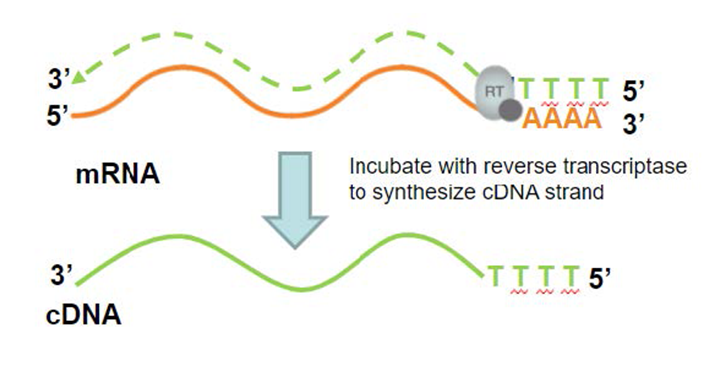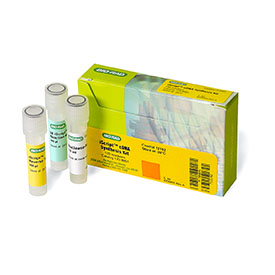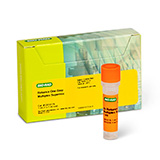
On This Page |
RT-qPCR Methods for Gene Expression |
One-Step RT-qPCR |
Two-Step RT-qPCR |
Differences in Reverse Transcriptase Reactions |
Related Products |
Resources |
During gene expression, once the RNA transcript is reverse transcribed into cDNA, the cDNA becomes the actual template for the qPCR amplification process. As RNA is more fragile than DNA, it is not suitable for PCR amplification. Therefore, RNA must be converted into complementary DNA (cDNA) first. A reverse transcriptase enzyme catalyzes the process of cDNA synthesis by using RNA as a template.

Figure 1. Steps to create cDNA from an mRNA template. Using an oligo(dT) primer, mRNA is reverse transcribed into cDNA. Afterwards this process is followed by hydrolyzation of the RNA strand.
RT-qPCR Methods for Gene Expression
Two methods are available for quantification of gene expression by RT-qPCR: “one-step” or “two-step” RT-qPCR. In both cases, RNA is reverse transcribed into cDNA, and the cDNA is then used as the template for quantitative PCR amplification. One-step or two-step refers to whether the reverse transcription and subsequent real-time PCR amplification are performed in the same or different tube.
In one-step RT-qPCR, cDNA synthesis and qPCR step occur in the same reaction. Two-step RT-qPCR uncouples cDNA synthesis and subsequent qPCR so they occur in separate reactions.
One-Step RT-qPCR
In one-step RT-qPCR, cDNA synthesis and qPCR are carried out inside the same reaction tube, in a common buffer, using gene-specific primers. Gene-specific primers direct cDNA synthesis and amplification of a specific target, and they typically anneal at higher temperatures compared to random primers. As a result, one-step protocols often use higher RT reaction temperatures than two-step workflows and can employ engineered or novel reverse transcriptase enzymes which tolerate higher reaction temperatures. Primary advantages of one-step reactions include minimal sample handling, reduced bench time, and closed-tube reactions, reducing the possibility of pipetting errors and cross-contamination. Therefore the one-step approach remains an ideal option for quantitating the same gene(s) repeatedly, which is particularly valuable in high-throughput applications and in diagnostic settings.
The quality and scarcity of RNA samples are important considerations for one-step RT-qPCR. Where RNA is of low quality, and inhibitors are inconsistently present between samples, reaction efficiency can be impacted to varying degrees, reducing comparability between samples. In addition, because the original cDNA synthesis product cannot be saved after one-step RT-qPCR, additional aliquots of the original RNA sample(s) are required to repeat reactions or to assess the expression of other genes.
Two-Step RT-qPCR
In two-step RT-qPCR, cDNA synthesis can be carried out using random hexamers, oligo-dT primers, and/or gene-specific primers. Reactions using random hexamers and/or oligo-dT primers produce cDNA that is a mixture of various RNA species in the sample. The cDNA synthesis reaction can be scaled up to accommodate higher RNA input, and extraction and precipitation steps can be used to concentrate and/or further purify the cDNA. Although the two-step workflow requires more time, it allows better control over the amount of cDNA template that is used for qPCR quantitation. Because only a portion of the cDNA product is used in the subsequent qPCR step, remaining cDNA can be stored for future use, or quantitating the expression of multiple genes from a single RNA/cDNA sample.
Two-step RT-qPCR uncouples cDNA synthesis and subsequent qPCR, allowing more options in the selection of RT enzymes separately from the qPCR reagents for amplification. This flexibility can be useful for controlling sequence representation, efficiency, and optimization of difficult RT-qPCR reactions.
The key drawbacks of two-step RT-qPCR are the extra open-tube step, greater number of pipetting manipulations, and longer hands-on time. The result is a greater possibility of variability and risk of contamination, and thus, two-step RT-qPCR is less amenable to high-throughput applications.
Differences in Reverse Transcriptase Reactions between One-Step and Two-Step
One-step RT-qPCR can be achieved either by using Thermus thermophilus (Tth) polymerase, a DNA polymerase with inherent RT activity, or by a two-enzyme system combining a reverse transcriptase with a thermostable DNA polymerase. Since Tth DNA polymerase is derived from a thermophilic bacterium, higher temperatures (>60ºC) can be used for the RT step, which can minimize secondary structure in high-GC-content mRNAs.
Accurate analysis of gene expression requires good reproducibility of reverse transcription reactions. The robustness of a reverse transcription is determined by the sensitivity, dynamic range, and specificity of the reverse transcriptase used. Reverse transcriptases from Moloney murine leukemia virus (MMLV) and avian myeloblastoma virus (AMV) are the most commonly used enzymes. When long or full-length cDNA transcripts are needed, MMLV reverse transcriptase and its derivatives are better choices than AMV reverse transcriptase due to their lower RNase H activity. It is has been observed, however, that RT reactions performed with RNase H– reverse transcriptases sometimes require subsequent RNase H treatment to effectively amplify certain templates and those at low concentration in the PCR.
As noted above, the reverse transcription step in two-step RT-qPCR can be performed using oligo(dT) primers, random primers, a mix of these two, or gene-specific primers. The choice of primers may influence quantification of your target gene. Gene-specific primers give less background priming than oligo(dT) or random primers. If you choose oligo(dT) primers for reverse transcription, you may want to place PCR primers close to the 3' end of the transcript to avoid loss of sensitivity due to truncated messages; this is especially important for longer transcripts. Oligo(dT) priming should be avoided if you are working with transcripts or species that have short poly(A) tails or lack them altogether. For the 5'-nuclease assay, we found oligo(dT)–primed cDNA to perform very well; however, random-primed cDNA performed equally well or slightly better for most sequences, and much better for some sequences. For most PCR applications, we have found best performance using iScript and iScript Select cDNA synthesis kits, which employ an MMLV RT.
Reverse Transcriptase Products
Ultimately, a good reverse transcription (RT) kit is useful to produce a complete and representative cDNA copy of the mRNA.
The hallmarks of a good RT kit include: 1) a mixture of random hexamers and oligo(dT)s to assure complete coverage of the transcriptome; 2) RNase H to digest the RNA while the cDNA is synthesized, which minimizes bias in cDNA production preventing the Cq values from being skewed to lower and variable values that would be unrepresentative of the true target amount in each sample; 3) an RNase inhibitor to prevent degradation of the RNA prior to RT; 4) a highly robust RT enzyme that permits RT of the widely ranging concentration of transcripts populating each sample. iScript Reverse Transcription Reagents from Bio‑Rad contain a blended mixture of each of these components to assure cDNA that closely reflects the transcriptome.
Reliance One-Step Multiplex Supermix from Bio-Rad offers a good example of a high-performance RT enzyme combined with an advanced reaction buffer which is designed for one-step RT-qPCR. The supermix format delivers reproducible performance for multiplexed RT-qPCR, and can be used with challenging RNA templates, difficult targets or in the presence of PCR inhibitors.
Related Products
-

cDNA Synthesis Kits
Ready-to-use, room-temperature stable, 4x reaction master mix optimized for sensitive amplification of up to 5 targets in a single reaction.
-

Reliance One-Step Multiplex Supermix
Ready-to-use, room-temperature stable, 4x reaction master mix optimized for sensitive amplification of up to 5 targets in a single reaction.
-

iTaq Universal One-Step Kit
High PCR efficiency in sensitive SYBR Green or probe assays, ideal for low-to mid-throughput real-time PCR screening and validation.
-

Preamplification Supermix
Ready-to-use supermix for unbiased, target-specific preamplification of cDNA or gDNA using up to 100 qPCR assays
Resources
-

Amplification and Reagents and Plastics Brochure
An overview of PCR reagents and plastics with info on specifications, performance data, and more.
-

End the Cycle of Repeated, Failed Experiments with a Robust Field Guide to qPCR
A snapshot of the critical steps needed to achieve excellent qPCR results.
-

Tips, Tricks & Best Practices for qPCR
Information on the best practices for designing qPCR experiments.
-

PCR Amplification Guide
A guide for RT-PCR on key concepts, experimental designs, analyses, and product recommendations.
-

Validating a Quantitative PCR (qPCR) Experiment to Minimize Error and Maximize Data Quality
A checklist of critical steps needed to achieve excellent results to performing a valid qPCR experiment.
